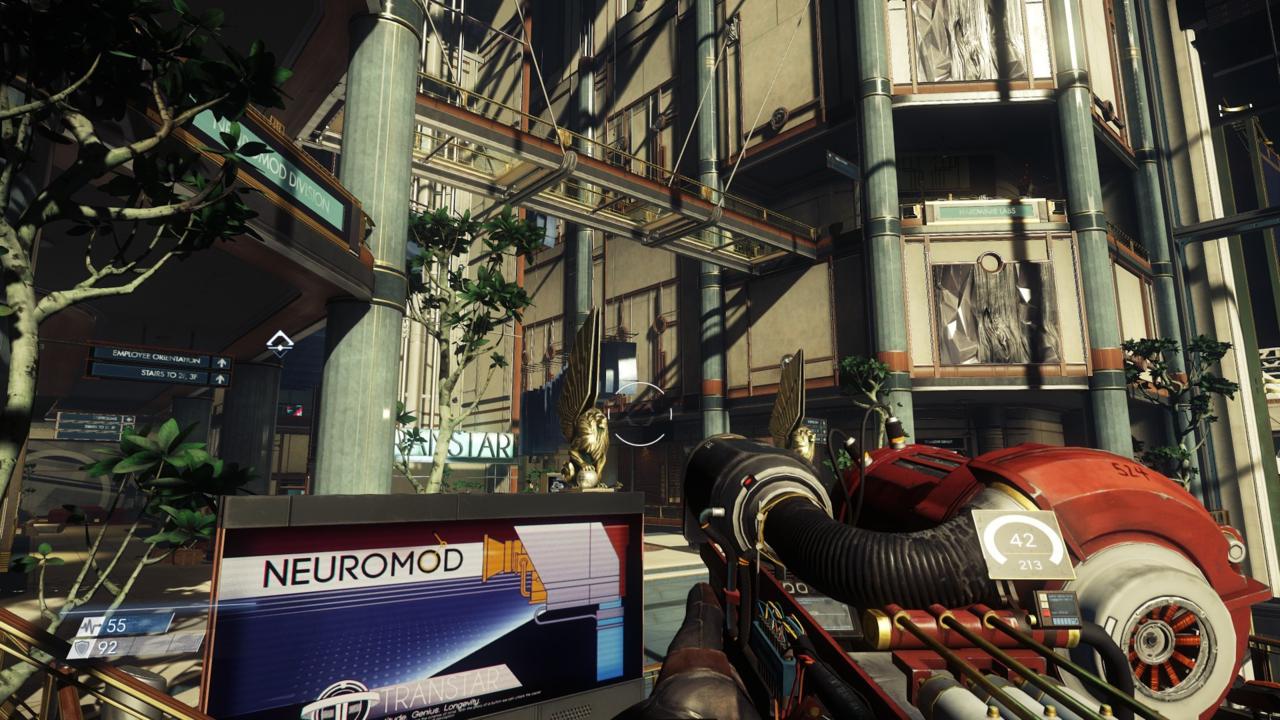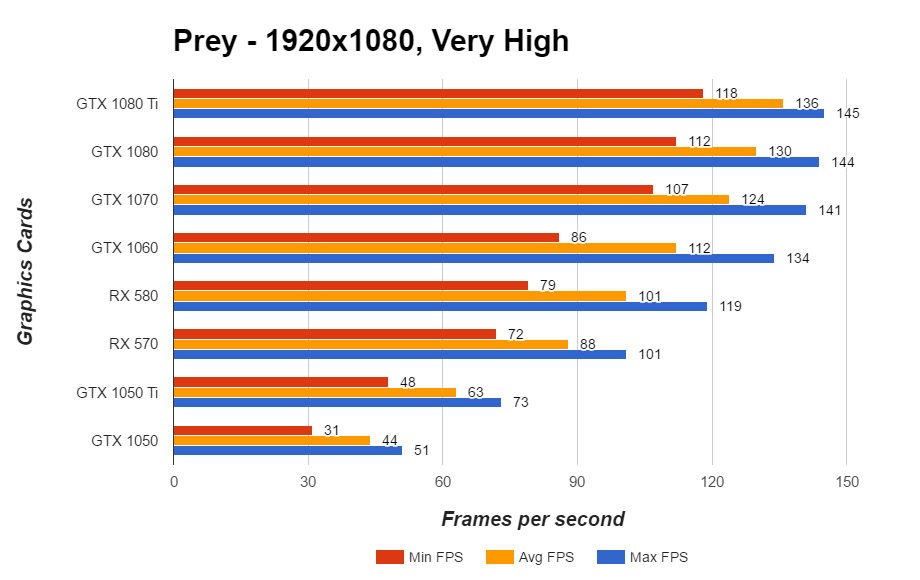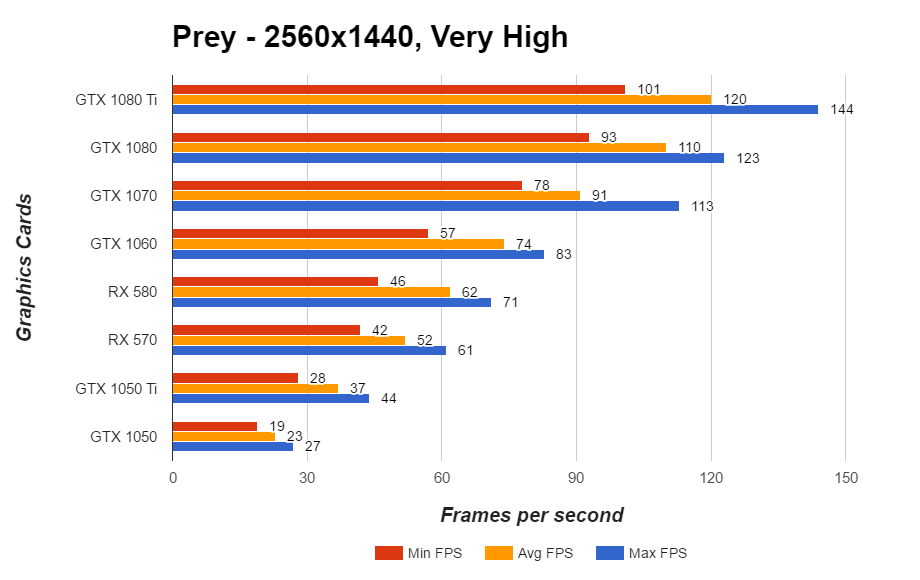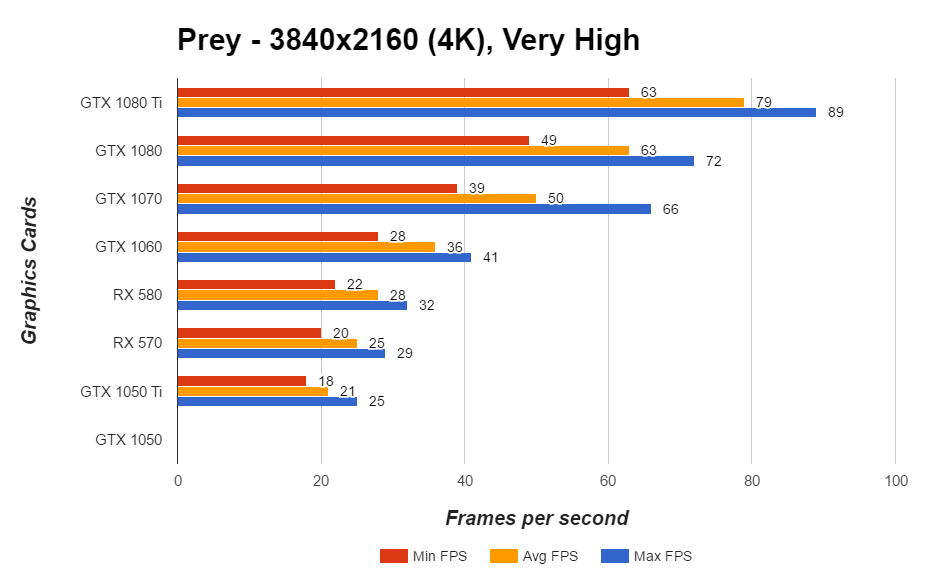Introduction
Prey is the latest immersive sim that taps into elements of System Shock while incorporating the feel of BioShock. The retro-futuristic vibe and Art Deco aesthetic make Talos I look striking, but how well do modern graphics cards hold up with Prey rendered at the highest quality settings? Arkane Studios, developer of last year’s Dishonored 2, ditched the Void Engine--which had some performance and stability issues--and moved to CryEngine to build Prey.
With eight graphics cards from the current generation--six from Nvidia, two from AMD--we put Prey through our own benchmark test. Since the game does not have a built-in benchmarking tool, we had to create our own repeatable sequence to get consistent results.
Methodology
The benchmark sequence began within the Talos I Lobby near the entrance to the Neuromod Division. From there we walked down the stairs to the center of the hall, all while getting a full view of the decor within the lobby area. Once at the center, we panned the camera around 360 degrees to get a feel for performance within the scenery. Then we walked around the main lift and into the TranStar Exhibit room to fight a Phantom that always spawns there. We shot it up with the GLOO Cannon and hammered it with the wrench, which concluded the sequence. By using the FRAPS program (which records frame data), we tracked the minimum, average, and maximum frames per second (FPS) through this 60 second tour.

We decided to run this test in three resolutions: 1920x1080 (1080p), 2560x1440 (1440p), and 3840x2160 (4K), all with V-Sync off. We also used the highest graphics preset for Prey (Very High) which includes the following settings:
- SMAA 2TX (anti-aliasing)
- 16x anisotropic filtering
- Full resolution screen space ambient occlusion
- Full resolution screen space reflections
- Very High shadow, texture, and object quality
Don’t be shy now; if you need a refresher on a few definitions of these terms, check out our PC graphics settings explainer!
Test Bench
We used the same rig from our previous benchmark stories--For Honor, Ghost Recon: Wildlands, and Mass Effect: Andromeda. It’s equipped with an Intel Core-i7 6700K clocked at 4.0GHz on a Gigabyte Z170 G1 Gaming motherboard. It also has 16GB of dual-channel HyperX Savage DDR4 RAM at 2133MHz. For storage, we have a 960GB Western Digital Blue solid-state drive. Most importantly, here are all the graphics cards included in our tests:
- Nvidia GTX 1080 Ti (Reference 11GB)
- Nvidia GTX 1080 (Reference 8GB)
- Nvidia GTX 1070 (Reference 8GB)
- Nvidia GTX 1060 (Reference 6GB)
- Nvidia GTX 1050 Ti (EVGA SC 4GB)
- Nvidia GTX 1050 (MSI OC 2GB)
- AMD Radeon RX 580 (Sapphire Nitro+ 8GB)
- AMD Radeon RX 570 (ASUS ROG Strix 4GB)
As with any big release, Nvidia and AMD put out day-one drivers to help optimize in-game performance. We used the version 382.19 driver for Nvidia cards, and the Crimson ReLive 17.5.1 package for AMD Radeon cards.
Benchmark Results
1080p Results

Prey is a breeze to run at 1080p even at maximum settings, if you’re using at least a GTX 1050 Ti. This relatively budget priced card put out an average of 63 FPS in our benchmark and only dipped to 48 FPS in when approaching the Phantom in the TranStar exhibit. The GTX 1050 didn’t fare as well, but still held up playable frame rates by averaging 44 FPS. We’d recommend turning down a few settings like shadows or anti-aliasing.
Our two AMD cards yielded impressive results considering their price. The RX 570 averaged over 80 FPS and never dropped below 60 FPS. The GTX 1060 slightly outperformed the RX 580, but at this point, anything faster is overkill unless you have a 120/144Hz monitor. Diminishing returns in frame rate settled in with the GTX 1070 and above.
1440p Results

Even at 1440p, mid-range cards like the GTX 1060 and RX 580 averaged above 60 FPS. We start to see a little bit more of a difference in performance between the higher-end cards, though they all stayed above 60 FPS through the entire benchmark sequence. Users of high refresh rate 1440p monitors should be happy to know a GTX 1070 will give them enough juice to enjoy their display’s perks.
The RX 570 squeezed out consistently playable frame rates by averaging 52 FPS and never dipping below 40 FPS--impressive for a sub-$200 graphics card. While the GTX 1050 Ti had a decent showing of a 37 FPS on average, it could benefit from lowering a few settings such as anti-aliasing or shadows. Technically, while the GTX 1050 could be enough to make Prey playable at 1440p at lower settings, we’d recommend switching to 1080p.
4K Results

Our 4K test really let the higher-end graphics cards show what they’re capable of. The GTX 1080 Ti had no problem staying above 60 FPS, getting an average of 79 FPS. We saw a slight hiccup when the GTX 1080 dropped to 49 FPS, but overall, its 63 FPS average felt smooth.
Things started to slow down with the GTX 1070, but the game was still very much playable. The card was able to hold 50 FPS on average and dipped to a minimum 39 FPS. The RX 580 and GTX 1060 fell behind by performing well under the GTX 1070, we’d recommend turning down anti-aliasing with these cards to get extra FPS boost, otherwise you'll want to use the 1440p resolution. The RX 570 squeaked out a 25 FPS average, so performance was less than ideal. As shown in the results, the GTX 1050 Ti is not meant to run games at 4K, and the GTX 1050 makes it simply unplayable.
Conclusion
Prey doesn’t ask much of your system, unless you’re at 4K resolution. Its environments are relatively contained within the Talos I space station, but still look clean and expressive. We don’t have to worry about crazy draw distances or multitudes of enemies hounding you at once (other than pesky mimics zipping across a room), but eye candy still demands a decent system.
If you’re hoping to enjoy Prey at 4K with max settings, you should at least be equipped with a GTX 1070 for playable frame rates. You could also turn down anti-aliasing at 4K to squeeze out extra frames, otherwise you’ll want a GTX 1080 or 1080 Ti for no compromises. Users of 1440p displays will be set with the mid-range GTX 1060 or RX 580 to get consistent 60 FPS at max settings. Those on 1080p displays should be thrilled to know that a GTX 1050 Ti is enough to pump out an average around 60 FPS.
Most systems with modern graphics cards should be in the clear to enjoy the game, so if you’re ready to jump in, check out our nine tips before starting Prey and the nine best neuromods regardless of play style.










